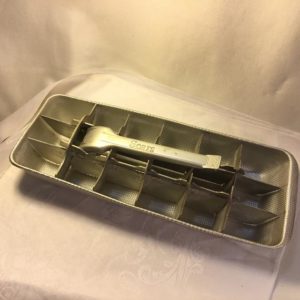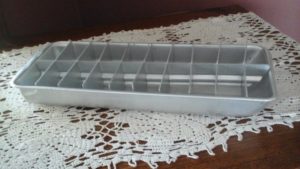
What would a hot summer day be without a tall glass of iced tea? Or what would a bourbon on the rocks be without the rocks?
In the scheme of things that are essential to life, ice cubes probably rate quite a ways down the list. But as far as the enjoyment of life is concerned, ice cubes are as essential as fuzzy slippers, the love of the right person, or your team winning the World Series.
We Boomer kids can recall when ice cubes were strictly a hit-or-miss proposition. Theoretically, we had plenty of them in the freezer. But in practice, getting cubes out of those infernally buggy aluminum ice cube trays was an act of skill, blind luck, and the grace of the freezer gods.
Oh, and don’t forget the wrath that would come down from mom and dad when a tray was left with one or two cubes of ice in it, instead of being refilled as we knew we should have done.
The ice cube tray’s invention is shrouded in a bit of mystery. According to one online source (about.com),
In 1914, Fred Wolf invented a refrigerating machine called the DOMELRE or DOMestic ELectric REfrigerator. The DOMELRE was not successful in the marketplace, however, it did have a simple ice cube tray and inspired later refrigerator manufacturers to include ice cube trays in their appliances as well.
No images of that original ice cube tray exist, nor even any detailed descriptions, as far as I can tell. But it wasn’t made of plastic, that much we know for sure.
As the twentieth century wore on, ice cube trays were made from lightweight, plentiful aluminum. A mechanized contraption was devised which would either expel the cubes when a lever was lifted, or when each individual divider was forced ahead by a fraction of an inch, releasing a single pair of cubes.
That last model was nearly impossible for a seven-year-old kid to operate, by the way.

And of course, the aluminum was pretty fragile. Many an ice cube tray divider was tossed in the trash after losing its ability to expel cubes due to stretching or breaking of the metal.
And that meant that the actual tray, which was still intact and %100 operational, would gain a second life as a catch-all in dad’s garage.
Somewhere along the line, plastics took over, even as Mr. McGuire predicted to Benjamin in The Graduate. The first plastic ice cube trays would get brittle after just a few uses, but by the time they broke, better ones were already on the market.
And as aggravating as the ever-snapping-plastic trays were, they still weren’t as annoying as an aluminum ejecting mechanism that broke in your hands as you were eagerly anticipating big ice cubes in your drink.
Nowadays, most of us get ice automatically made for us in our high-tech freezers. How sweet it is.
But let’s face it. As nice as our automatic ice makers are, they make for really lousy catch-all trays in the garage when they finally break down.
I think the name of the film referred to as “Mrs. Robinson” is “The Graduate”.
You’re absolutely right. How did that one slip by? Fixed, thanks.